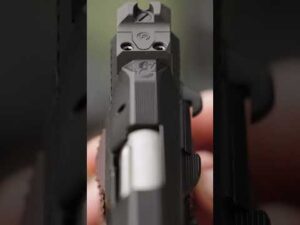This article is from the Criterion Barrels Website. This article offers conservative, good advice on barrel cleaning. Cleaning methods may have to be adjusted to the amount and type (and barrel) of fouling. We try to avoid brushing and follow the Criterion recommended procedures, which respect the crown/muzzle. We have also found that wet patches, followed by Wipe Out bore foam, are very effective. You may also want to use Wipe-Out bore foam along with the practices described below by Criterion. Use a bore guide fitted with a cleaning rod to keep the foam away from the action recesses or trigger assembly. The video above shows how to use Wipe-Out, or any other bore-cleaning product. We use a slightly differing method. We use 3-4 wet patch to remove loose carbon fouling. We then apply the foam in the manner shown, but typically from the muzzle (with the bore guide in the chamber). After 20-30 minutes and after the bubbles have gone down, we apply the foam again to get more active ingredients into your barrel. After 3-4 hours, we patch the barrel as shown. Improper barrel-cleaning methods can damage or destroy barrels, resulting in diminished accuracy or even a catastrophic failure. There are many other useful barrel maintenance techniques that we haven’t listed. Some techniques work better on different barrel types. This series of recommendations was designed to incorporate methods that the Criterion Barrels team has successfully used both in the shop as well as on their own rifles. Please feel free to add your own suggestions in the comments section below. We recommend the use the following components when cleaning rifles:o Cloth patch (sized for the caliber)o A brass jag that is sized correctly for your bore (Aluminum or nylon jägers will also work)
One-piece coated cleaning rod
Hoppes #9 is a good example of a general bore cleaner/solvent.
o Copper Solvent of your choice (Example : Sweets/KG12)
o Fitted bore guide for cleaning rod
Plastic AP brush or toothbrush
Q-Tips
o Plastic dental picks
There are different schools of thought regarding the frequency of cleaning a barrel. We recommend cleaning the barrel after every shooting session in order to remove copper and carbon buildup. Condensation poses the greatest immediate danger, as it can cause rusting of the barrel while the rifle is in storage. Copper and carbon buildup can negatively impact barrel performance in the future, increasing the risk of failures in feed or function. When possible, fouling should be removed. The tips below will help you limit the wear on different parts of your barrel when performing routine maintenance. This will extend the barrel’s life and improve its performance.
If copper fouling occurs during the initial break-in of the rifle, be sure to check our barrel break-in article. For regular maintenance, we recommend using a single-piece coated cleaning rod instead of the traditional segmented or bore snake. While segmented rods or bore snakes are convenient for use in the field, the corners can bow out and catch the lands. This will scrape along the length of rifling. The grit from spent cartridges can also get stuck between segments and create an abrasive surface that runs the length of the barrel. Bore snakes can remove a significant amount of carbon fouling but they may not be able to remove copper fouling and residual carbon buildup during deep cleaning. There are many manufacturers that make good rods, but we’ve had good results with both Pro-Shot brand and Dewey products. For general cleaning, patches work better than nylon or brass brushes. Brass brushes are useful for aggressive cleaning, but they can cause barrel wear if used too often. The reason for this is not the soft brushes, but the abrasive grit particles that are embedded in the material being repeatedly run through the bore. Bore guides are recommended for cleaning the muzzle as well as the breech. These bore guides protect the crown and the throat from damage caused by the cleaning rod. If there is significant resistance while running the cleaning tool through the bore, it should not be forced in any further. The rod should be backed out and the barrel inspected to determine the source of the resistance. The jag could be digging a divot in the barrel by pushing between a bore obstacle and the rifling before pushing the obstruction through the muzzle. The initial push can be made with a smaller patch to reduce the risk of a rod getting stuck. Cleaning the length of the rifling requires a relatively simple process. Check that the rifle is unloaded.
2. Before cleaning, disassemble any items that need to be removed.
3. Remove bolt (if you can) and insert the cleaning rod bore guide.
4. Soak a patch (similar to Hoppes #9) in bore solvent.
5. Insert the brass jag into the chamber end. Center and attach the patch. If the patch is not centered, it may cause the jag’s lands to be damaged. [Note: An aluminum or nylon jag won’t show a false positive.]
6. Retract the patch when you reach the muzzle.
7. Let the solvent rest for a few minutes.
8. Continue to run patches until the carbon residue is minimal.
9. To ensure that carbon residue is removed, run a dry patch along the bore.
10. Soak a patch (Sweets or KG-12) in copper solvent.
11. Run the patch through bore, allowing it to sit there for 3-5 minutes. (Do not let the solvent sit longer than 15 minutes. *)
12. Repeat the process until there is no blue residue left on the patches.
13. To neutralize the copper solvent, run a patch Hoppes #9 through the bore and then a dry patch.
14. Before reassembling the rifle inspect the barrel to ensure that there are no obstructions in the bore. Please note that some copper solvents containing ammonia can be corrosive when left in the barrel for a long time. These solvents must be removed within 15 min to avoid damaging the bore.
The angle where the bullet last touches the bore of the barrel is the most critical area for accuracy potential. Avoid damaging this area by using CLP type cleaner and a plastic brush to scrub the crown of the barrel. Even the slightest variation in the crown’s wear will have a negative impact on barrel performance. Be careful not to nick or wear away this part of your barrel.
When you run a patch down the barrel, make sure to place the muzzle at least 1/4″ away from a flat surface that is perpendicular to the direction of travel of the cleaning rod, such as a wall or edge of a table (pictured). By removing the patch when the jag hits the hard surface you will reduce the chance of brass dragging on the crown in the event that the rod is bent or misaligned. The soft cloth patch will serve as a point of contact between jag and barrel, minimizing wear. If possible, insert rod through chamber, pushing it toward muzzle. For some rifles such as the M1 Garand and M14, you will need to insert the rod through the muzzle. Avoid using cleaning rod segments to scrape carbon from the recessed nozzle of an AR-15 barrel. This trick was used in the Marine Corps in order to impress armorers and NCOs with the cleanliness our muzzles. However, it probably played a major role in reducing service life of the rifle. The amount of carbon left on the muzzle face will not affect bullet travel as long as the crown edges remain consistent around the bore.
Cleaning the chamber properly is an important part of any cleaning procedure. The chamber is the most difficult part of the barrel for cleaning due to its size fluctuations and awkward ergonomics. Many chamber-specific devices have been developed to combat this problem. While some should be avoided, such as steel chamber brushes, others can be used with great success (such as cleaning stars and dental picks). To clean a chamber, apply solvent to a few patches and then use the cleaning rod inside the chamber to spin them. This should help remove any excess carbon. A Q-Tip is useful for reaching areas of the chamber that are not reachable by patches.
The finish of the firearm should also be cleaned following handling. Rust or corrosion can be caused by condensation, humidity, water contact and salt residue on the skin. When storing a firearm in deep storage, it is recommended that you apply anti-corrosion products. [Editor AccurateShooter.com recommends Corrosion X or Eezox but other products also work well. Finding Cleaning Components Although most cleaning components are available at your local gun store, some specialty items will need to be purchased through online retailers like Brownells. Criterion uses both Dewey brand and Pro-Shot cleaning components in our daily operations. Do you have any other tips or tricks for cleaning rifles that are not mentioned in this article? We’d like to hear them. You can post them below.Similar posts:Tags Abrasive cleaner, Barrel cleaning, Bore Guides, Criterion Barrels and Foam Cleaner.

















